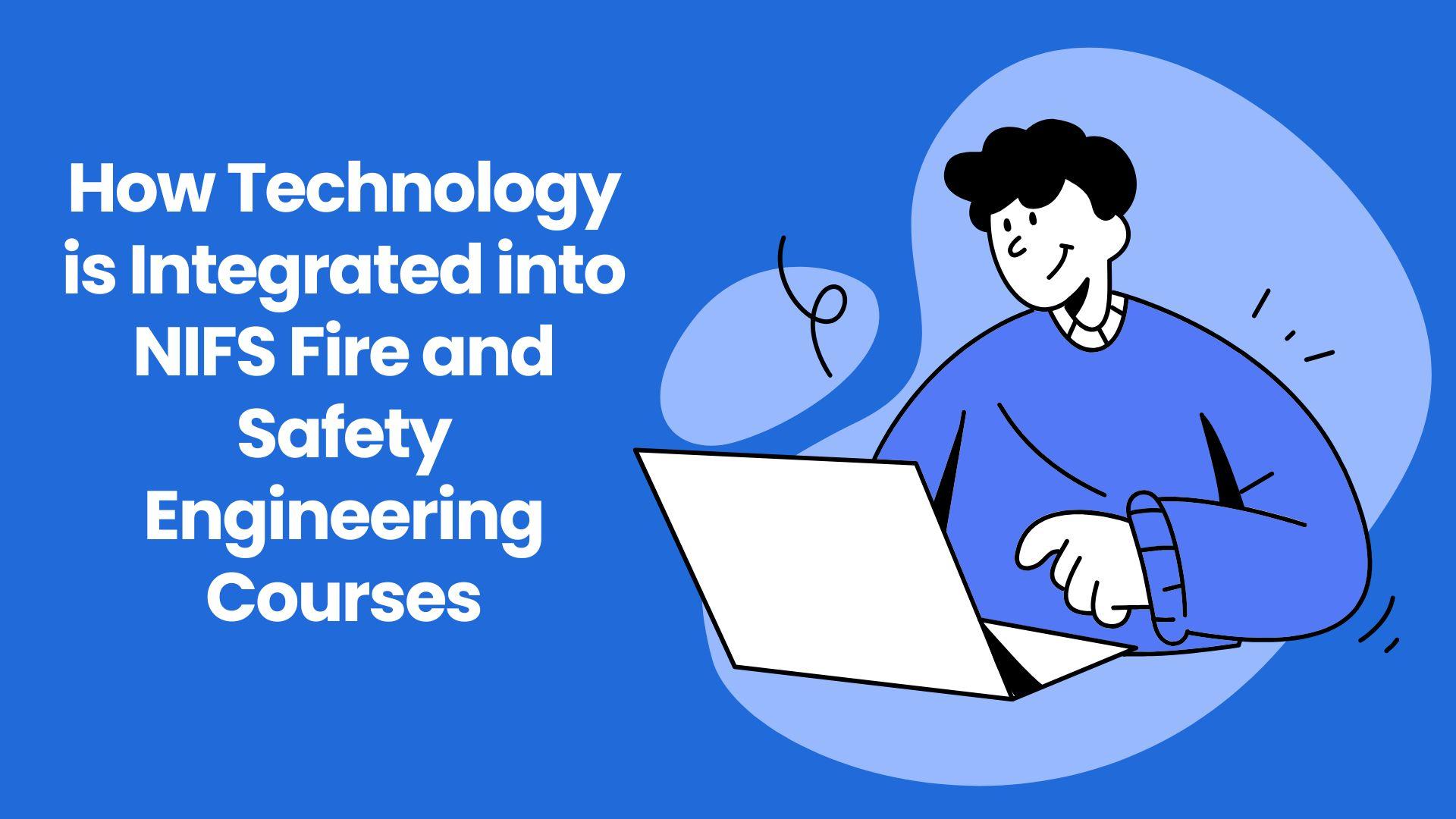How Technology is Integrated into NIFS Fire and Safety Engineering Courses

In today’s fast-evolving industrial world, safety has become one of the most critical aspects of any workplace. Industries are not only required to comply with strict safety regulations but also ensure that their employees are trained with modern techniques to handle emergencies effectively. This is where the role of fire and safety engineering courses becomes indispensable. Among the institutions offering such programs, the National Institute of Fire and Safety Engineering (NIFS) stands out for its innovative approach, particularly in integrating modern technology into its curriculum.
Technology has transformed every field, and fire and safety education is no exception. At NIFS, the use of advanced technological tools and methods ensures that students gain practical, real-world skills that go beyond textbooks. This article explores how technology is integrated into NIFS Fire and Safety Engineering Courses and why this makes their graduates highly sought after by employers across industries.
1. Simulation-Based Training for Real-Life Emergency Scenarios
One of the most notable ways technology is integrated into NIFS courses is through simulation-based training. Fire emergencies, chemical leaks, explosions, and natural disasters are difficult to replicate in traditional training environments. However, with advanced simulation tools, students can now experience these situations virtually.
-
Virtual Reality (VR) and Augmented Reality (AR) are used to simulate real-world hazards. For example, a student can virtually navigate through a fire-affected building to learn evacuation strategies without any risk.
-
These simulations allow learners to practice decision-making under pressure, ensuring they are better prepared to respond effectively in real-life emergencies.
-
This technology not only enhances engagement but also builds confidence among learners before they step into practical fieldwork.
2. Smart Firefighting Equipment Training
Modern firefighting relies heavily on advanced equipment, and NIFS ensures that its students are familiar with these tools. The integration of smart firefighting equipment into the curriculum provides learners with hands-on experience in handling the latest technology.
-
Thermal imaging cameras are used to detect hotspots in fire-affected areas, helping students understand how professionals locate hidden fire sources.
-
Drones for aerial surveillance are increasingly used by fire safety teams to monitor large industrial zones or inaccessible areas. NIFS introduces students to drone-assisted inspections to highlight the future of firefighting operations.
-
Training also includes the use of IoT-enabled safety devices that monitor air quality, temperature, and gas leaks in real time.
By engaging with such tools, students not only gain theoretical knowledge but also develop the ability to operate and interpret modern safety equipment.
3. Digital Classrooms and E-Learning Modules
Traditional chalk-and-board methods have been replaced by digital learning platforms at NIFS. The institute leverages modern technology to make classroom sessions more interactive and accessible.
-
Smart classrooms equipped with projectors, animations, and 3D visuals help students grasp complex fire dynamics and chemical reaction processes more effectively.
-
E-learning modules and online resources are provided to students so that they can revisit lectures, access additional study material, and prepare for examinations at their own pace.
-
Web-based learning also ensures that distance learners or working professionals can access course material remotely without compromising on quality.
This integration of digital classrooms into fire and safety engineering education ensures that learners remain connected with knowledge anytime, anywhere.
4. Use of CAD and Fire Modeling Software
Designing safe buildings and industrial environments requires expertise in fire modeling and risk analysis. At NIFS, students are introduced to Computer-Aided Design (CAD) and fire modeling software that help them understand fire behavior in various structures.
-
Software such as PyroSim, Pathfinder, and AutoCAD is often used to simulate smoke movement, evacuation routes, and fire spread.
-
By learning how to analyze building layouts and identify potential hazards through technology, students develop skills that are highly valuable in roles like fire safety auditing and industrial safety consultancy.
This not only prepares them for technical roles but also enhances their problem-solving and analytical abilities.
5. Online Assessment and Certification Systems
NIFS integrates digital assessment systems to evaluate students’ knowledge and skills more effectively.
-
Online tests, interactive quizzes, and digital assignments allow students to apply theoretical concepts in practical scenarios.
-
Certification processes are also digitized, making it easier for students to obtain globally recognized certifications after completing their course.
These digital evaluation methods ensure that students receive timely feedback and can track their progress efficiently.
6. Research and Data Analytics in Safety Management
Modern safety engineering is not only about reacting to hazards but also about predicting and preventing them. To achieve this, NIFS incorporates data-driven learning into its courses.
-
Students are introduced to data analytics tools that help in identifying patterns in workplace accidents, fire incidents, and industrial hazards.
-
By learning how to analyze safety reports and statistics, students can recommend proactive safety measures for industries.
-
This technology-driven approach prepares learners for advanced roles in safety management, where predictive analysis plays a crucial role in risk reduction.
7. Cloud-Based Learning and Collaboration
Collaboration is a key part of fire and safety education, and NIFS uses cloud technology to make teamwork easier and more efficient.
-
Students can access study material, share projects, and collaborate on assignments through cloud-based platforms.
-
Instructors can provide real-time guidance and feedback, even remotely, ensuring continuous learning.
-
Cloud integration also ensures that learners are well-prepared for corporate environments where digital collaboration is the norm.
8. Integration of Artificial Intelligence (AI) and IoT in Curriculum
The future of safety management lies in AI and IoT (Internet of Things), and NIFS ensures its students are well-prepared for this transformation.
-
AI-powered systems are introduced to demonstrate how predictive algorithms can forecast fire risks in industrial setups.
-
IoT devices, such as smart fire alarms, connected smoke detectors, and automated sprinklers, are discussed to highlight their role in modern safety infrastructure.
-
By studying AI and IoT applications, students develop a futuristic outlook and remain ahead in the competitive job market.
9. Virtual Industrial Visits and Online Guest Lectures
Another innovative way NIFS integrates technology is through virtual industrial visits and online guest lectures.
-
With the help of virtual tours, students can explore factories, power plants, and construction sites without geographical limitations.
-
Industry experts from across the globe are invited to conduct webinars, giving students direct exposure to global safety practices and trends.
This not only enhances industry readiness but also broadens students’ perspectives beyond local practices.
10. Placement and Career Assistance through Digital Platforms
Finally, technology also plays a role in how NIFS connects students with career opportunities.
-
Online placement portals help students connect with recruiters from India and abroad.
-
Virtual career counseling and interview preparation sessions equip students with the skills needed to excel in competitive job markets.
With digital placement support, students enjoy better access to employment opportunities across industries.
Note: check our other courses fire and safety QHS courses
Conclusion
The integration of technology into NIFS Fire and Safety Engineering Courses ensures that students are not just learning theory but are also equipped with practical, futuristic skills. From simulation-based training and advanced firefighting equipment to AI-driven safety systems and digital learning platforms, technology is embedded in every aspect of the curriculum.
This forward-thinking approach makes NIFS graduates highly competent and globally competitive. By blending traditional knowledge with modern innovations, NIFS ensures that its students can confidently face the challenges of modern industries and contribute to creating safer workplaces worldwide.







